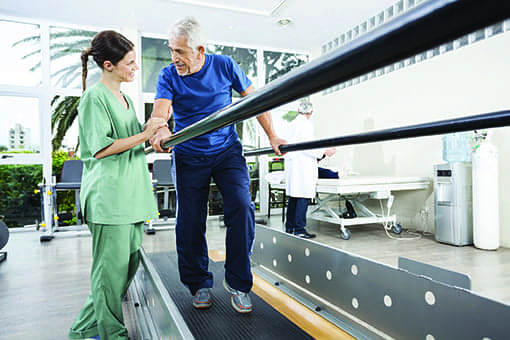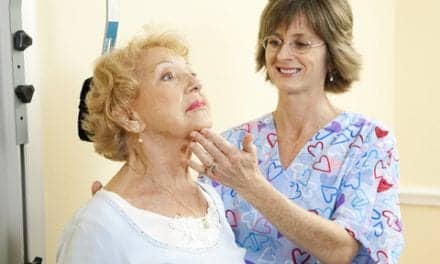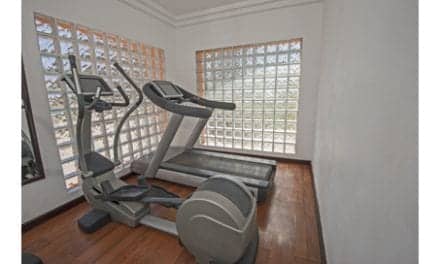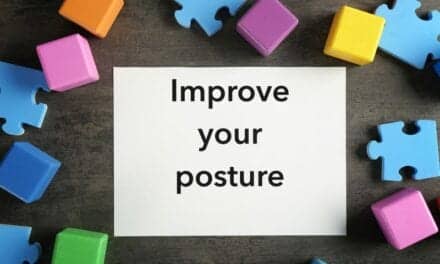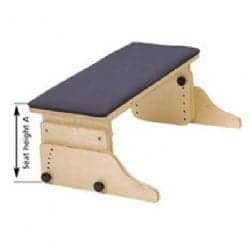By Anthony E. Salafia, PT, DPT, MA, CSCS, and Jeff Steckler, OTR
In real estate, it’s all about location. The same is true for any business that needs to be in a practical location with access for clients and adequate room for a variety of uses. For any clinic whose future plans include an increasing clientele and a larger footprint, a space that will facilitate growth is a critical consideration. Such was the case when California Rehabilitation, Modesto, Calif, recently searched for a new facility with the aim of serving a community that had a shortage of outpatient clinics focused on providing quality neurological, gait and balance rehabilitation. After conducting an extensive search, the right building with the size, accessibility, and amenities to realize this vision was found. Having resolved the issue of physical space, the next major task was to determine the best equipment to bring aboard to address the populations affected by deficiencies in balance and weight-bearing. Making those determinations required a calculus of physical space, well-trained staff, and financial commitment to invest in the clinic.
[sidebar float=”right” width=”250″]Product Resources
The following companies offer products that can be used for stroke and neurological rehabilitation:
Accelerated Care Plus
www.acplus.com
APDM
www.apdm.com
Allard USA Inc
www.allardusa.com
Biodex
www.biodex.com
Clarke Health Care Products
www.clarkehealthcare.com
DIESTCO MFG CORP
www.diestco.com
GAITRite / CIR Systems Inc
www.gaitrite.com
Gorbel Inc-Medical Division/SafeGait
www.safegait.com
Hocoma
www.hocoma.com
Micromedical Technologies Inc
www.micromedical.com
Mobility Research
www.litegait.com
ProtoKinetics
www.protokinetics.com
Therapeutic Industries
www.therapeuticindustries.com
Vista Medical
www.boditrak.com[/sidebar]
Serving Stroke and Neuro Needs
The target population in this case is an underserved group of mostly neurologically impaired patients with a higher level of complexity. One person every 40 seconds is affected by stroke, and it is the leading cause of long-term disability in the United States.1 Stroke and certain age-related changes are not the only causes of gait impairment. Body system functions including vision, posture, sensation, and vestibular issues can have an adverse effect on gait outside of age.2 The majority of outpatient clinics in the Central Valley region of California—for various reasons, ranging from a lack of expertise to choosing not to invest in the higher level of care required to work with less able patients—have opted out of providing adequate care for neurologically impaired patients. Some of the basic activities of daily living and gait needs include the ability to safely ambulate through a crosswalk with a minimum of .5 to .6 miles per hour pace.3 For many stroke survivors and other lower extremity impaired, this is not safely possible. Balance and being able to ambulate at a useful pace are keys to regaining functional independence.
Body weight support systems, computerized balance systems, gait mats, and various other types of locomotor training devices can advance the level of rehabilitation services a clinic provides. These devices require an initial significant financial investment. Budgets, clinical settings, and patient populations served will all be factors in what is ultimately purchased. Questions such as the return on investment, clinical efficacy, and practicality of use all need to be thoroughly explored.
• Body weight support systems (ceiling mounted and over ground or over treadmill)
• Gait mats and electronic walkways
• Computerized balance systems
Body weight support systems (BWS) provide an environment or rehabilitation tool rather than simply a treatment approach. These technologies provide better comfort, confidence, and safety for the patient and clinician, while allowing for a higher intensity and productive treatment. BWS improved speed, weight on limbs, visual conflict, response to perturbations, accuracy of step placement, and improved neuromuscular gait pattern are measures of intensity.4 This can result in improved stance phase muscle strength and coordinated movement.1
Some of the technologies for facility-based BWS solutions include the Lokomat and Andago from Hocoma Inc USA, Norwell, Mass. The Lokomat provides functional robotic gait therapy with features such as augmented performance feedback and an adjustable robotic gait orthosis over a treadmill platform that enables intensive training. The Andago provides dynamic BWS and allows users to walk freely, at their own speed, over a floor surface while wearing a harness that protects against falls.
Another gait training device that can simultaneously control weight bearing, balance, and posture is the LiteGait from Mobility Research Inc, Tempe, Ariz. The LiteGait harness design permits unilateral or bilateral support, and provides postural control on the frontal, sagittal, and transverse plane. It is designed to be used over a treadmill or over ground, and to lift patients of varying height and weight from sit to stand.
Body weight support units of varying levels of sophistication can be found online used, but that type of purchase sacrifices warranty protection and the level of customer support and clinical education that comes with the purchase of a new unit. The investment for new BWS devices can vary with weight capacity and other options. At the high end of the technology, ceiling-mounted, trolley-based systems or robot-assisted treadmill-style devices can cost well beyond $100,000 and require structural modifications to the space they occupy.
Peroneal Nerve stimulator cuffs that address drop foot are excellent tools that provide better symmetry and weight shift in gait. These products are about $4,995 for a kit including the stimulator cuffs, electrode pads, software, and training/support by professional staff.
Analyzing Gait
Gait mats are useful for objectively analyzing gait pre- and post therapy episodes. Space is a consideration, and user-friendliness and cost will drive the purchase choice. Higher-end gait mats with sensors, cameras, and sophisticated software can range from $30,000 to more than $50,000 with higher levels of temporospatial measuring and reporting. Less sophisticated choices such as phone apps can cost less than $50 but will not likely withstand peer-reviewed scrutiny. The PT market has several sources for technologies that analyze gait.
CIR Systems, Franklin NJ, offers a line of GAITRite walkways in a variety of lengths that roll out for quick and easy deployment. GAITRite CIRFace offers a snap together wifi walkway that permits a variety of layouts including step-up and over elevations, turns, and circles. All systems compute over 90 measurements including all the standard measures (cadence, velocity, step length, stride length etc.), as well as numerous symmetry measures. Reports and displays can be tailored to measurements most useful for a specific clinical condition.
Another gait analysis system, The Zeno Walkway from ProtoKinetics, Havertown, Pa, houses a 16-level pressure sensing pad designed to collect and analyze temporal, spatial, and pressure data. The Zeno Walkway is designed to be portable or installed for permanent use, and is available in configurations that accommodate static standing, straight walking, turning, or other maneuvers.
ROI: More Than Meets the Eye
Return on investment (ROI) can come in many forms. One dimension of ROI—providing clinicians the right tools for the job—is important to any health care professional, and making the investment to provide the latest technologies for therapists and patients to succeed helps build employee satisfaction and retention. Assuring staff and patients conduct their activities with equipment that is safe and reliable also contributes to satisfaction among all the clinic’s stakeholders. Training, too, is a critical investment.
The goal, overall, is patient satisfaction, which ultimately helps strengthen reputation. Patients will share their good experiences with their physicians, who will in turn refer more of their balance-impaired patients to this clinic. They will also share their positive experience with others who are going through a similar dysfunction. There is no better testimonial than a good outcome and an enjoyable experience.
Clinics that truly specialize in neurological rehabilitation are uncommon in most communities. Physicians and other referral sources often must refer their neurologically impaired patients into clinics that see a higher volume of lower-complexity patients. Rehabilitation potential is often not realized in these settings where the staff doesn’t have the knowledge, time, and the equipment/tools to maximize the opportunities to help patients functionally improve. When word spreads, however, that the staff, equipment/space, and outcomes achieved are geared toward balance and gait improvement, referrals will increase. The return on investment is then not just a measure of clinical viability, but it becomes a measure of the commitment to meeting the needs of the community. It is the wise rehabilitation manager who recognizes that there is room to improve, and takes the necessary steps to do so. PTP
Anthony E. Salafia, PT, DPT, MA, CSCS, is a physical therapist/clinical instructor at California Rehabilitation, Modesto, Calif, and an adjunct professor in the Kinesiology Department at Stanislaus State University in Turlock, California.
Jeff Steckler, OTR, Owner/CEO of California Rehabilitation, Modesto, Calif, provides volunteer sports medicine support for the Modesto City Schools and organizes a collective group of medical professionals who conduct pre-participation sports physicals for hundreds of high school students each year. For more information, contact [email protected].
References
1. Mulroy SJ, Klassen T, Gronley JK, Eberly VJ, Brown DA, Sullivan KJ. Gait parameters associated with responsiveness to treadmill training with body weight support after stroke: an exploratory study. Phys Ther. 2010 Feb;90(2):209-23.
2. Shumway-Cook A, Woollacott M. Motor Control: Translating Research into Clinical Practice. 3rd Edition. Philadelphia, PA: Lippincott, Williams & Wilkins Publishing; 2007.
3. Robinet CS, Vondran MA. Functional ambulation velocity and distance requirements in rural and urban communities: a clinical report. Phys Ther. 1988;68:1371-1373.
4. Studer M. Support the body to pick up the pace toward independence. Rehab Management. July 2012. Retrieved from http://www.rehabpub.com/2012/07/support-the-body-to-pick-up-the-pace-toward-independence/

